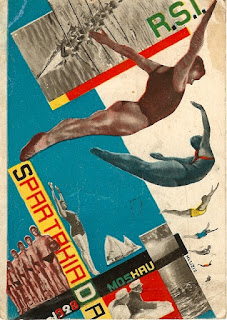" The First Working Group of Constructivists (including Liubov Popova, Alexander Vesnin, Rodchenko, Varvara Stepanova, and the theorists Alexei Gan, Boris Arvatov and Osip Brik) would develop a definition of Constructivism as the combination of faktura: the particular material properties of an object, and tektonika, its spatial presence. "
" Constructivism encouraged a new focus on the tangible and material aspects of art, and its experimental spirit was encouraged by a belief that art had to match the revolutionary transformations then taking place in Russian politics and society. "
El Lissitzsky
Proun Vrashchenia
Rodchenko
Spatial Construction no 12 (1920)
"This material choice reflects the early Constructivist idea that everyday objects and materials should be used to create abstract works of art, which broadened the conceptual definitions of art in general. "
Van der Leck
Van Doesburg
A movement founded by Theo Van Doesburg, De Stijl, is particularly interesting to me. The movement explored geometric abstract art. Many artist creations by the members of De Stijl have great significance to abstraction and composition, such as Rietveld's chair and Schröder House, however the paintings are something I want to explore further.
Piet Mondrian has always inspired me particularly his later works using horizontal and vertical lines combined with primary colours. This non-representational work follows on from his experiments in the Cubist period, for example Red Tree evolving to Gray Tree (below) both painted in early 20th century incorporate geometric shapes to represent the tree. His later works are much more graphic, which is something I want to take across into my own work when considering stripped back compositions.
Malevich
From these initial experiments evolved avant garde aesthetic across Europe to modernist graphic design, much of which is seen in 21st century work. Minimalism and reductionist appearance in design spread through the mid-20th century with focus on space as a key to visual communication.
shape / tone / space / volume / balance / weight
After mismatching and recreating some constructivist compositions found through my research I began to work from my own photographs, ones I have already taken having been inspired by this kind of graphic art. This is probably something I will develop in this project, working from compositions found in everyday life and made two dimensional through photography.
I've also looked into typography within constructivist / Russian avant-garde posters, particularly post-revolution Russia. The idea of using a montage of paint, photo collage and type interests me, linking back to the Dada reference of experimentation with mediums not of the norm.
Gustav Klutsis
A dynamic city (1919). The above image by Klutsis is of a constructivist nature and shows the clear starting point of his later development to dynamic graphic compositions using both collage photographs and text. Some examples below. What I like about these is their dynamism, which is balanced both in scale and direction across the image as a whole, creating visually sound compositions.
Rodchenko
Georgii and Vladimir Stenberg
This form of communication is striking and I feel it communicates a strong message with great impact, which is why I have chosen to use this style to influence my own work.
Another element I want to include is the use of adding and sticking other found materials to the canvas', making physical collages out of smaller found objects, e.g. newspaper, cardboard, plastics, etc.
For my piece or pieces in the exhibition I plan to 'beautify' found objects and canvases, by creating graphic artwork on materials I find, elongating their life cycle by using them to produce work. Hence my interest in dynamic composition and the above movements and styles. These work well as a pure, stripped away aesthetic as a simplistic grid by which I can transfer typography and calligraphy on to the found materials I am collecting.
By developing my own compositions and structures through use of photography as inspiration I plan to develop striking images that force us to look at the issue of repurposing old resources and materials through this bold, geometric aesthetic.


































No comments:
Post a Comment